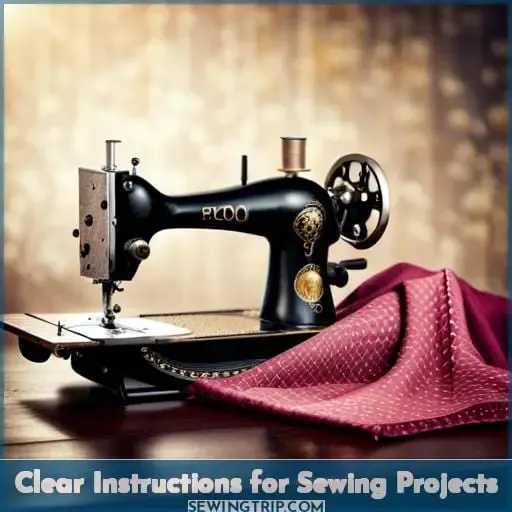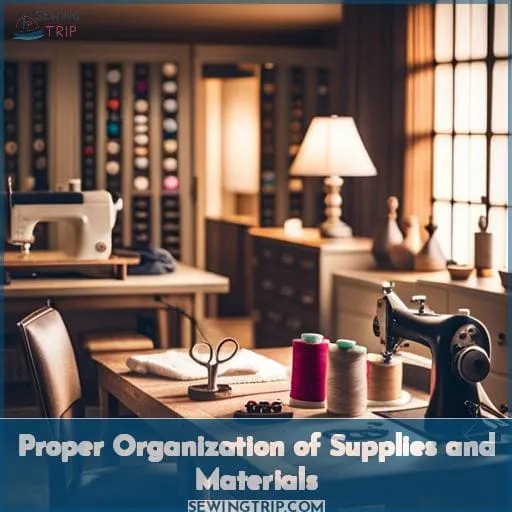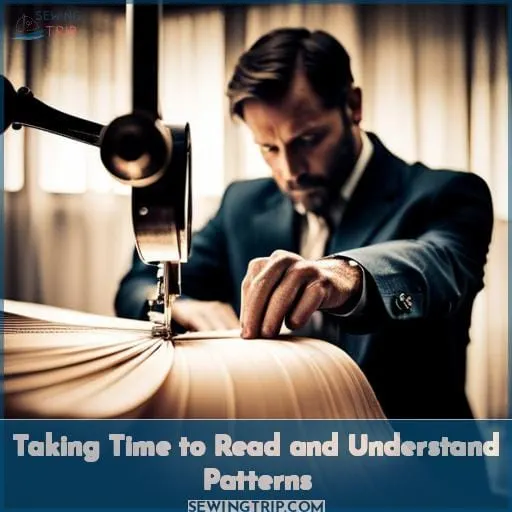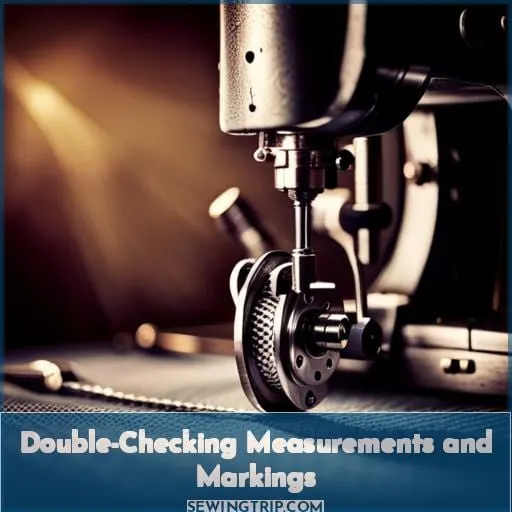This site is supported by our readers. We may earn a commission, at no cost to you, if you purchase through links.
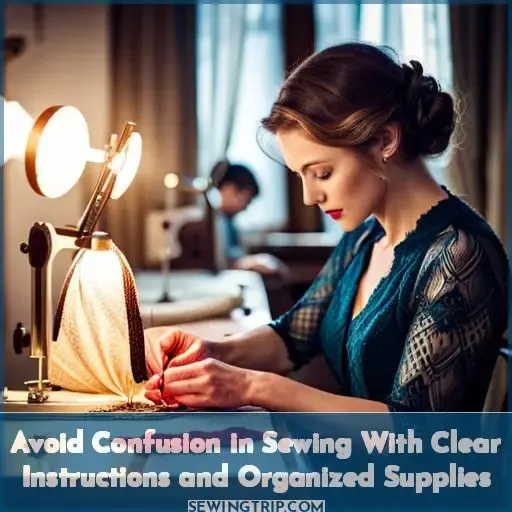 Ready to take your sewing skills to the next level? Avoid confusion in your projects with clear instructions and organized supplies. Whether you’re a beginner or an experienced seamstress, having precise directions and neatly arranged materials will make all the difference.
Ready to take your sewing skills to the next level? Avoid confusion in your projects with clear instructions and organized supplies. Whether you’re a beginner or an experienced seamstress, having precise directions and neatly arranged materials will make all the difference.
In this article, we’ll show you how to eliminate any guesswork by providing step-by-step guidance and tips on keeping everything in order.
Table Of Contents
Key Takeaways
- Clear instructions and visual aids are crucial for sewing success.
- Proper organization of supplies and materials is essential for an efficient sewing process.
- Take the time to read and understand patterns, clarifying any confusing terms or instructions.
- Double-check measurements and markings to ensure accuracy in the sewing project.
Clear Instructions for Sewing Projects
When it comes to sewing projects, clear instructions are essential for avoiding confusion and ensuring successful outcomes.
As a seasoned seamstress/tailor or sewing instructor, you understand the importance of providing detailed step-by-step directions that guide your students or customers through each stage of the process.
Visual aids or diagrams can also be incredibly helpful in illustrating techniques and highlighting important points.
By prioritizing clarity in your instructions, you empower others to confidently tackle their sewing projects with ease and precision.
Detailed Step-by-step Directions
To ensure clarity and ease in your sewing projects, follow detailed step-by-step directions.
Utilize visual aids, maintain an organized workspace, measure accurately, make clear markings to avoid confusion.
Achieve tidy results by avoiding puckering and thread nests while sewing with lining fabric.
Use of Visual Aids or Diagrams
When you’re following a sewing pattern, clear instructions and organized supplies are essential for success. Visual guides provide clarity by visually representing the steps involved in your sewing projects.
- Diagrams enhance understanding of complex techniques.
- Instruction visuals eliminate confusion and guesswork.
- Clear sewing steps with visual aids ensure accurate execution.
Highlighting Important Points or Techniques
Continue enhancing your sewing skills by highlighting important technique tips in clear instructions.
Use visual aids and diagrams to ensure pattern clarity.
Organize your supplies for easy access and accuracy in measurements, including traditional techniques like sashiko kasane.
Proper Organization of Supplies and Materials
To ensure a smooth and efficient sewing process, it’s crucial to properly organize your supplies and materials.
Preparing your materials before starting will save you time and avoid confusion later on.
Keeping all of your supplies organized and easily accessible will allow you to work more efficiently, while labeling and storing materials after use will help maintain an organized sewing space for future projects.
Preparing Materials Before Starting
Before you start sewing, prepare materials and organize supplies.
Choose fabrics for your project.
Select appropriate thread.
Interpret patterns correctly.
Familiarize yourself with essential sewing techniques.
These steps will ensure successful execution of finishing touches on your garment.
Keeping Supplies Organized and Easily Accessible
To keep your sewing supplies organized and easily accessible throughout your project, start by setting up a designated workspace.
Utilize storage solutions such as bins or shelves to optimize sewing efficiency and ensure efficient supply management.
Labeling and Storing Materials After Use
Once you have finished using your sewing supplies, it’s important to properly label and store them for easy access and organization.
- Use clear labels to identify each type of supply.
- Sort fabrics by color or project.
- Invest in storage solutions like bins or shelves.
- Follow a system that works best for you in managing materials effectively.
Taking Time to Read and Understand Patterns
Now it’s time to focus on the importance of taking your time to read and understand patterns in order to avoid confusion while sewing.
As a skilled seamstress or tailor, you know that clarifying any confusing or unfamiliar terms is crucial for accurate pattern interpretation.
By following the instructions provided with precision, you can ensure a smooth and successful sewing experience without any unnecessary setbacks.
Clarifying Any Confusing or Unfamiliar Terms
When reading and understanding patterns, clarify any confusing or unfamiliar terms to ensure accurate sewing.
Take the time to familiarize yourself with the pattern glossary and sewing terminology.
Don’t be afraid to ask for clarification or look up definitions if needed.
Understanding instructions is key to mastering your sewing projects and avoiding any mistakes caused by misinterpretation of jargon.
Following Pattern Instructions Accurately
When following pattern instructions accurately, take the time to read and understand them thoroughly in order to avoid any confusion or mistakes.
Seek clarity in the instructions and guidance provided by the pattern designer.
Create an organized workspace where you can focus on reading, comprehending, and implementing these instructions with utmost accuracy.
Double-Checking Measurements and Markings
Now that you have learned the importance of taking time to read and understand patterns, let’s discuss the next crucial step in avoiding confusion in sewing: double-checking measurements and markings.
As a skilled seamstress or tailor, it’s essential to use precise measuring tools such as rulers, measuring tapes, and pattern guides to ensure accuracy. Remember to measure multiple times from different angles before making any cuts or adjustments.
Additionally, make clear and visible markings on your fabric using chalks or marking pens so that you can follow them easily throughout the sewing process.
Using Precise Measuring Tools
To ensure accurate measurements and markings in your sewing projects, take the time to use precise measuring tools.
- Use a tape measure or ruler
- Mark with fabric chalk or tailor’s pencil
- Measure multiple times for accuracy
- Follow clear instructions carefully
Measuring Multiple Times to Ensure Accuracy
To ensure precise measurements and markings in your sewing projects, double-check them multiple times.
Utilize effective measuring techniques for accuracy assurance.
Take the extra step to make multiple measurements and avoid errors, ensuring precision in your sewing endeavors.
Making Clear and Visible Markings on Fabric
Make sure you double-check your measurements and markings on the fabric to ensure accuracy in your sewing project.
Use precision techniques such as marking fabric with clear, visible guidelines.
Utilize visual aids and follow pattern clarity for optimal results.
Frequently Asked Questions (FAQs)
What are some common mistakes to avoid when sewing?
To avoid confusion when sewing, make sure to:
- Measure accurately and double-check your pattern.
- Take your time with cutting and pinning, ensuring precision.
- Pay attention to details like seam allowances and fabric grain.
- Practice patience for flawless results!
How do I choose the right fabric for my sewing project?
To choose the right fabric, consider the project’s purpose and desired outcome.
Assess factors like drape, weight, and stretch.
Experiment with swatches to test for ease of sewing and durability.
Trust your instincts; you’re on your way to mastery!
What are some tips for sewing intricate details and small components?
To master intricate details, focus on precision.
Pin small components in place to avoid shifting.
Employ delicate stitching techniques for a polished finish.
How can I prevent my sewing machine from jamming or skipping stitches?
To prevent jamming or skipped stitches, ensure your sewing machine is properly threaded and the needle is inserted correctly.
Use high-quality thread and change needles regularly.
Keep an eye on tension settings and clean your machine regularly for smooth stitching every time.
Are there any special techniques for sewing stretchy or delicate fabrics?
To sew stretchy or delicate fabrics,
- Use a ballpoint needle
- Adjust the tension on your machine
- Test stitches on scrap fabric beforehand
- Consider using a stabilizer for added support.
Conclusion
To avoid confusion in your sewing projects, it’s essential to have clear instructions and organized supplies.
With detailed step-by-step directions, visual aids, and highlighting important points, you can eliminate any guesswork and achieve successful results.
Properly preparing materials, keeping supplies organized, and labeling them after use will also contribute to a smooth sewing experience.
Take the time to read and understand patterns, clarify any confusing terms, and follow instructions accurately.
By double-checking measurements and making clear markings on fabric, you can ensure accuracy and avoid any sewing mishaps.
So, say goodbye to confusion and hello to seamless sewing sessions!

